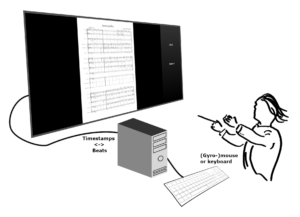Conducting is the great art of bringing a lot of different people together to perform a piece of music in one coherent way. The skills required to achieve that are manifold and cannot all be learned and practiced by oneself. Often enough one needs an ensemble or even a whole orchestra to experience the reactions to and then work on the ideas and gestures. With the aid of the digital world some basic exercises might help to be better prepared for the work with a bigger ensemble and therefore be able to concentrate rather on the creative and musical aspects of conducting than on technical problems.
A first step towards a set of digital learning tools is a game which begins to tackle the problem of a slightly delayed response time of the musicians to the conductor’s beat. Usually the conductor has to conduct slightly ahead of the orchestra to get the intended tempo and timing. This lag between the visual beats and the resulting sound is not a fixed value but varies from orchestra to orchestra, from conductor to conductor and also depends on the actual music (faster tempos are usually conducted in a tighter manner whereas slow passages allow for more time difference).
This game approaches the problem from a very basic starting point. There are two different pieces of music which the player can choose from. The beats of the recording are to be matched either by pressing the SPACE key on the keyboard or by moving the mouse up and down, ideally a gyro mouse which can be hold similar to a conductor’s baton. The difficulty of this game is that the action of the player should be executed 150-400 ms before the sounding beat.
With the simplicity of this game we try to learn how basic the level of learning tools should and could be to provide a retainable learning effect. At which point is the abstraction between the actual practical application and the game too great? Training the art of conducting ahead can be refined in several ways: using a camera as input so that the gestures become more natural, shaping the music by gestures rather than re-conducting a recorded version, adjusting the response time depending on the tempo of the music.


